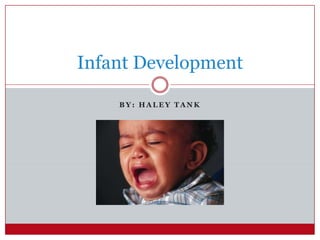Infant development
•Transferir como PPTX, PDF•
2 gostaram•1,409 visualizações
Denunciar
Compartilhar
Denunciar
Compartilhar

Recomendados
Recomendados
Mais conteúdo relacionado
Mais procurados
Mais procurados (20)
Factors Affecting Growth & Development of children

Factors Affecting Growth & Development of children
Growth and development of all age groups | Juhin J

Growth and development of all age groups | Juhin J
Destaque
Destaque (20)
Pstti introduction of physical education in pre school children

Pstti introduction of physical education in pre school children
Preschool teachers training institute@gurjit kaur class 6 9-15

Preschool teachers training institute@gurjit kaur class 6 9-15
Maidan Summit 2011 - Saroj Yadav, National Council of Educational Research an...

Maidan Summit 2011 - Saroj Yadav, National Council of Educational Research an...
Unlimited Fun With Independent Activities in Preschool

Unlimited Fun With Independent Activities in Preschool
Technical Presentation: Child Development, Health, and Nutrition

Technical Presentation: Child Development, Health, and Nutrition
Semelhante a Infant development
Semelhante a Infant development (20)
Developmental Stages Week 7Christina Sierra 1Sub.docx

Developmental Stages Week 7Christina Sierra 1Sub.docx
359724731-Development-during-Infancy-and-Toddlerhood-ppt.ppt

359724731-Development-during-Infancy-and-Toddlerhood-ppt.ppt
Mais de haleytank
Mais de haleytank (6)
Infant development
- 1. Infant Development BY: HALEY TANK
- 2. Infants
- 3. Milestones 2 Months: Smile, gurgle, look at parent, follow objects with eyes 4 Months: Plays with people, copies sounds he hears, let‟s you know feelings, rolls over 6 Months: Recognize faces, bounces when stood up, can sit without assistance 9 Months: Clingy to toys and people, understands “no”, crawls, pulls self to stand. 12 Months: Follows directions, copies adults, holds onto furniture, stands, walks without assistance
- 4. Physical Development •At birth, most infants movements are reflexes. •During the first months, infants can see clearly objects that are about 10 inches away from their faces. •By four months, most babies have some control of their muscles and nervous system. •By six months, their vision is more fully developed. •They can sit with support, hold their head up for short periods of time, and can roll from their side to their stomach. •By five months, most babies can roll over. •Eat three meals a day and need bottles throughout the day. •Start to use utensils to feed themselves. •Eight months, can sit up and throw things. •By 12 months their weight has tripled since birth. •Walking around one year old.
- 5. Emotional/Social Development •Trust their parents as they need them to change diapers, for feeding, and to hold them. •They cry to express anger, fright, pain and hunger. It is their way of communicating. •Newborn infants smile in response to a pleasant sound or a full stomach. •At about six weeks, they smile in response to someone else. •By four months, they smile broadly, laugh when pleased, and learn to recognize faces and voices of parents.
- 6. Language Development Infants coo and babble to practice making sounds with their mouths. They learn simple sounds like da, ga, ba, etc. Mama and Dada often come next. Or easy words that are often repeated in the infants surroundings. Child may answer with „ya‟ or „no.‟
- 7. Cognitive Development Infants coo, babble, and gurgle. They study their hands and feet and the world around them. They can locate the sounds around them. Their world is explored through their mouths. Older infants learn to play Pattie-cake and peek-a- boo. They repeat actions that give them a response. They can respond to yes or no, and simple directions.
- 8. Encouraging Infant Development Use positive verbal cues when infant is learning a new skill. (ex. sitting, rolling, standing, walking) Place safe items in a reachable distance for infant to grab, roll, crawl for and eventually grasp. Allow child to climb objects safely with supervision. Place spoon or crayon in baby‟s hand to practice cause and effect and small motor skills. Be verbal with infant.
- 9. Red Flags No big smiles by 6 months. No back and forth sharing of expressions. No words, meaningful syllables by 12 months. Child‟s arms, legs seem too floppy or too stiff. Child favors one side of body. Child has difficulty eating or drools too much. Infant is not tracking objects with his or her eyes. Child is not responding to loud sounds. Child cannot self-sooth or be calmed.
- 10. Cultural Development Language differences Parental preferences Cultural practices Special Education Religious beliefs